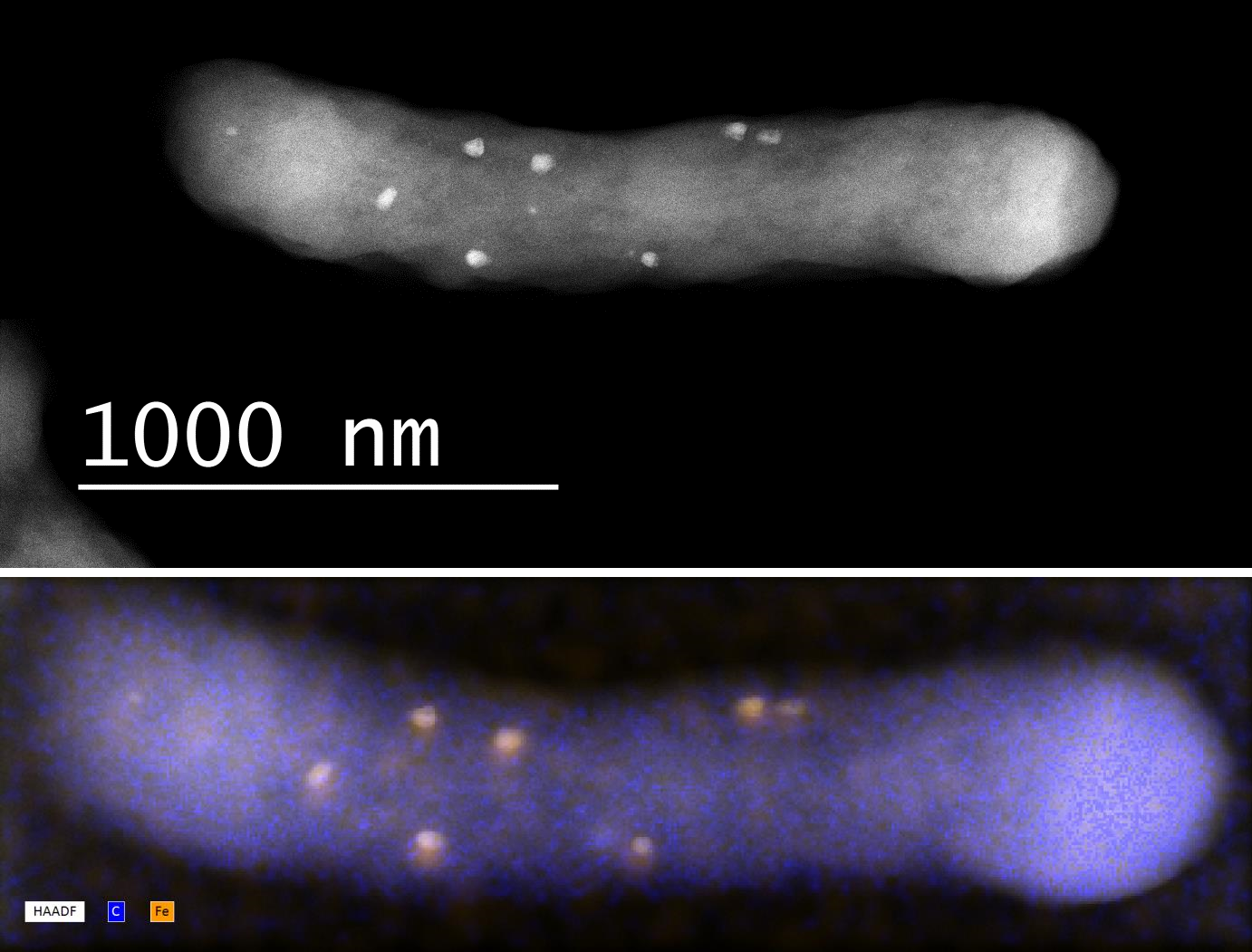Project description and motivation
In our project we work with Rhodospirillum rubrum magneticum, a gram-negative, microaerobic bacteria. Naturally it’s not able to produce magnetosomes, but with genetic engineering they received this ability, naturally found in Magnetospirillum (microbe of the year 2019) strains. Latter thrive in the sediments of freshwater streams or marine sediments in very low oxygen environments[5] and need the magnetosomes to find their preferred habitat. The so called magnetosomes, spherical vesicle-like and membrane-coated particles, contain biomineralized ferrite monocrystals and have an approximate diameter of 45nm. Because of being surrounded by a lipid bilayer, their membrane can be functionalized.

Transmission electron micrograph (TEM) of a cell of Rhodospirillum rubrum magneticum showing the intracellular “ironoxide containing vesicles” –so called magnetosomes. The magnetite crystals have an average diameter of ~45 nm. The iron content was verified by EDX. Iron is portrayed in orange while carbon is portrayed in violet.
Magnetosomes are currently being tested for their application in biomedicine and analytical sciences. We want to functionalize and use them for a project which will tackle an environmental problem.
Since they became widely available in the 1950s, humanity has collectively produced more than 8.3bn tons of plastics, only 9% of which got recycled, while 79% remained in the environment, in landfills or the oceans[1]. With a yearly input of 8m tons, these pollutants will outweigh all fish in the oceans by 2050[2], but they are already hurting the marine ecosystem severely. An equally dangerous, yet mostly invisible threat is posed by microplastics, particles smaller than 5mm, generated by degradation via wave motion and UV radiation, which in turn can work their way into the marine food chain[3] and eventually into the human body[4]. Another problem is the detection of micro-and nanoplasticparticles. Nowadays if someone wants to detect and differ between plastics a mass spectrometer is needed. But it’s a costly and elaborate way. We want to create an easier and cheaper way!

Our goal is to create novel fusion protein (as shown above) embedded into the vesicular membrane of magnetosomes (M), able to specifically bind certain polymers, for example polypropylene (PP).
Between the binding domain and the anchor, a fluorescent protein is integrated to enable an easy detection through fluorescence. By using different colours for different binding peptides a distinction between plastics, like PS or PP, will be enabled.
The Sources:
1. Geyer R, Jambeck JR, Law KL (2017), Production, use, and fate of all plastics ever made., Sci Adv., doi: 10.1126/sciadv.1700782
2. Ellen MacArthur Foundation (2016), The new plastics economy: Rethinking the future of plastics.
3. Nelms SE, Galloway TS, Godley BJ, et al (2018) Investigating microplastic trophic transfer in marine top predators. Environ Pollut. doi: 10.1016/j.envpol.2018.02.016
4. Meeker JD, Sathyanarayana S, Swan SH (2009) Phthalates and other additives in plastics: human exposure and associated health outcomes. Philos Trans R Soc B Biol Sci. doi: 10.1098/rstb.2008.0268
5. Frankel RB, Bazylinski DA (2005) Magnetosomes: Nanoscale Magnetic Iron Minerals in Bacteria. In: Nanobiotechnology.
